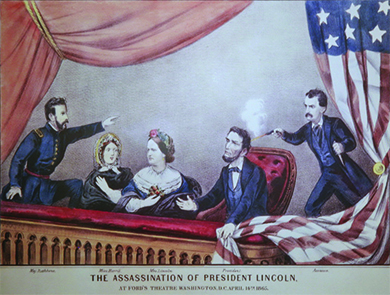| << Chapter < Page | Chapter >> Page > |

Lincoln’s assassination elevated Vice President Andrew Johnson, a Democrat, to the presidency. Johnson had come from very humble origins. Born into extreme poverty in North Carolina and having never attended school, Johnson was the picture of a self-made man. His wife had taught him how to read and he had worked as a tailor, a trade he had been apprenticed to as a child. In Tennessee, where he had moved as a young man, he gradually rose up the political ladder, earning a reputation for being a skillful stump speaker and a staunch defender of poor southerners. He was elected to serve in the House of Representatives in the 1840s, became governor of Tennessee the following decade, and then was elected a U.S. senator just a few years before the country descended into war. When Tennessee seceded, Johnson remained loyal to the Union and stayed in the Senate. As Union troops marched on his home state of North Carolina, Lincoln appointed him governor of the then-occupied state of Tennessee, where he served until being nominated by the Republicans to run for vice president on a Lincoln ticket. The nomination of Johnson, a Democrat and a slaveholding southerner, was a pragmatic decision made by concerned Republicans. It was important for them to show that the party supported all loyal men, regardless of their origin or political persuasion. Johnson appeared an ideal choice, because his nomination would bring with it the support of both pro-Southern elements and the War Democrats who rejected the conciliatory stance of the Copperheads , the northern Democrats who opposed the Civil War.
Unexpectedly elevated to the presidency in 1865, this formerly impoverished tailor’s apprentice and unwavering antagonist of the wealthy southern planter class now found himself tasked with administering the restoration of a destroyed South. Lincoln’s position as president had been that the secession of the Southern states was never legal; that is, they had not succeeded in leaving the Union, therefore they still had certain rights to self-government as states. In keeping with Lincoln’s plan, Johnson desired to quickly reincorporate the South back into the Union on lenient terms and heal the wounds of the nation. This position angered many in his own party. The northern Radical Republican plan for Reconstruction looked to overturn southern society and specifically aimed at ending the plantation system. President Johnson quickly disappointed Radical Republicans when he rejected their idea that the federal government could provide voting rights for freed slaves. The initial disagreements between the president and the Radical Republicans over how best to deal with the defeated South set the stage for further conflict.
In fact, President Johnson’s Proclamation of Amnesty and Reconstruction in May 1865 provided sweeping “amnesty and pardon” to rebellious Southerners. It returned to them their property, with the notable exception of their former slaves, and it asked only that they affirm their support for the Constitution of the United States. Those Southerners excepted from this amnesty included the Confederate political leadership, high-ranking military officers, and persons with taxable property worth more than $20,000. The inclusion of this last category was specifically designed to make it clear to the southern planter class that they had a unique responsibility for the outbreak of hostilities. But it also satisfied Johnson’s desire to exact vengeance on a class of people he had fought politically for much of his life. For this class of wealthy Southerners to regain their rights, they would have to swallow their pride and request a personal pardon from Johnson himself.
For the Southern states, the requirements for readmission to the Union were also fairly straightforward. States were required to hold individual state conventions where they would repeal the ordinances of secession and ratify the Thirteenth Amendment. By the end of 1865, a number of former Confederate leaders were in the Union capital looking to claim their seats in Congress. Among them was Alexander Stephens, the vice president of the Confederacy, who had spent several months in a Boston jail after the war. Despite the outcries of Republicans in Congress, by early 1866 Johnson announced that all former Confederate states had satisfied the necessary requirements. According to him, nothing more needed to be done; the Union had been restored.
Understandably, Radical Republicans in Congress did not agree with Johnson’s position. They, and their northern constituents, greatly resented his lenient treatment of the former Confederate states, and especially the return of former Confederate leaders like Alexander Stephens to Congress. They refused to acknowledge the southern state governments he allowed. As a result, they would not permit senators and representatives from the former Confederate states to take their places in Congress.
Instead, the Radical Republicans created a joint committee of representatives and senators to oversee Reconstruction. In the 1866 congressional elections, they gained control of the House, and in the ensuing years they pushed for the dismantling of the old southern order and the complete reconstruction of the South. This effort put them squarely at odds with President Johnson, who remained unwilling to compromise with Congress, setting the stage for a series of clashes.
President Lincoln worked to reach his goal of reunifying the nation quickly and proposed a lenient plan to reintegrate the Confederate states. After his murder in 1865, Lincoln’s vice president, Andrew Johnson, sought to reconstitute the Union quickly, pardoning Southerners en masse and providing Southern states with a clear path back to readmission. By 1866, Johnson announced the end of Reconstruction. Radical Republicans in Congress disagreed, however, and in the years ahead would put forth their own plan of Reconstruction.

Notification Switch
Would you like to follow the 'U.s. history' conversation and receive update notifications?